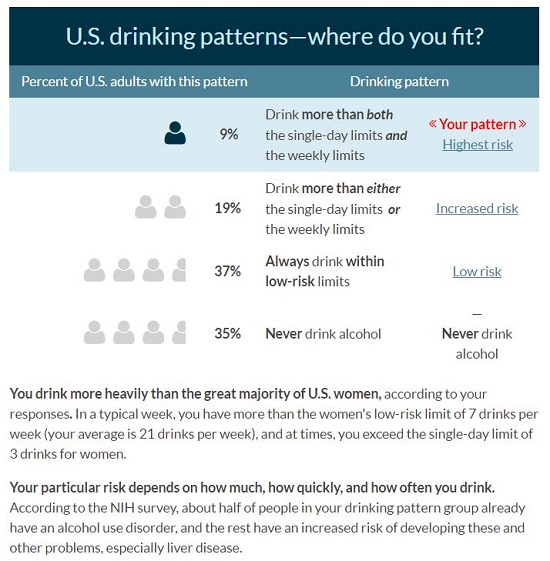For society, sure, the central problem with alcoholism is alcohol and the behaviors that result when a person is using it or continues to use it. But for a person with alcoholism, the central problem isn’t alcohol. It’s abstinence. For a person with alcoholism or other substance use disorders, the anguish, enormity and complexity of the inner experience of abstinence is usually beyond bearing.
This inner experience is portrayed painfully and poignantly in HBO’s documentary, Risky Drinking, released December 19, 2016. The film follows the alcohol use of four people, considered “risky drinkers. Here’s a link to more about the film.
“People don’t drink because they’re crazy; they drink because it works in some way.”
– Carrie Wilkens, Ph.D., interviewed in Risky Drinking and quoted on the film’s site and interviewed for The Fix
The discussion guide for Risky Drinking includes this caution: “Before you watch, a note of caution: this film contains content and images that some – especially those struggling with an alcohol use disorder – may find disturbing.”

I would extend that caution. Both those struggling with alcohol use disorder – and those who love them and have tried to help them – might find the film disturbing, even traumatizing. As someone in both categories, I had to take a break midway, and still found myself sobbing helplessly at the end.
With 4 years of abstinence from alcohol, I’m in the early part of the 4-5 year range named in the Surgeon General’s report on addiction to be considered in remission from alcohol use disorder, but I am determinedly trained in emotion regulation skills, primarily through dialectical behavior therapy, DBT, so I was able to do what I needed to do to handle images in the film. Top precursors for return to active use for those with substance use disorders are 1) stress/distress and 2) environmental cues. Film viewers will experience #1 and may experience #2. For some people, viewing Risky Drinking may be too risky. Those with less time abstinent or nascent self-soothing skills may want to wait to watch it.
If you can tolerate watching Risky Drinking, then it’s a must-watch. While I appreciate that over 2 million American are estimated to have opioid use disorder, over 16 million Americans are estimated to have alcohol use disorder. If the first number qualifies as a crisis, the second qualifies as an apocalypse. In Risky Drinking, you will see what I have seen in myself, what I have seen in and heard from others, and what plagues of Americans. I know all the people in this film, personally and professionally, just by different names.
And I am one of them.
I unequivocally recommend taking the drinking pattern self-assessment on the Rethinking Drinking site linked to from the Risky Drinking site, produced by the National Institute on Alcohol Abuse and Alcoholism (NIAAA), a part of the National Institutes of Health. It only has two questions. Yesterday, I entered numbers on the low side for my drinking pattern before I began abstaining nearly 4 years ago at the end of 2012. I’ve included a screenshot of my results.
The producers would like to thank the participants in this documentary for sharing their varying struggles with alcohol, in their desire to help others.
Their participation took great courage.
– Risky Drinking
In early 2012, my individual counselor told me of this NPR story on a CDC report on women and drinking. I remember reading it, then looking for and taking online self-assessments, none as clear and definitive as the one offered on the Rethinking Drinking site, and feeling a growing sense of horror. Nor did I find such helpful, supportive suggestions as these. I did try harder to cut back and to stop, but abstinence itself induced the primary precursor to relapse: stress and distress.
If I realized I had a drinking problem today in 2016, I can’t know if I would have done things differently than I did in 2012. But I can’t have done worse. I told no one, including my counselor, physician, family members or friends. I drank nearly the full amount I had been drinking every day prior, then, without detox, headed to a support group. While the people in support groups have been lovely, the Surgeon General’s report excludes support groups from the category of treatment and relegates them to the “recovery support services (RSS)” category. I threw myself off a cliff into the torturous chasm of untreated abstinence and it took me years to recover my footing.
In 2012, I thought I had contracted a moral problem and hid my secret in shame. In 2016, thanks to Facing Addiction, Maia Szalavitz, the Surgeon General, and other pioneers, I would know I had developed a medical problem – malfunctions identifiable in specific brain structures – and I would take myself to a doctor.
Perhaps those who watch Risky Drinking and take the assessment can help themselves on their own, get early, good help, or do whatever it takes to get help in their locale, and feel better and do better faster than the people in the film – and than I did – and we can all get on with fully living our beautiful, precious lives.

